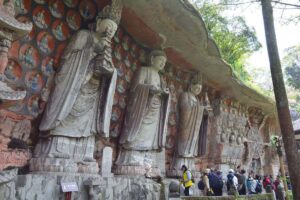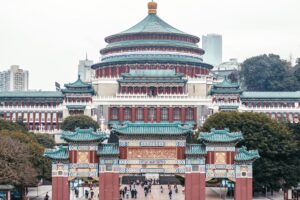History of Chongqing Part 2
Chinese History Chart

The first part was about history of Chongqing from B.C. to Northern and Southern Dynasties (南北朝) era.
The Part 2 will introduce Sui (隋) to modern history
The simplified Chinese history chart is as as below;
・Xia (夏): B.C.2100 – B.C.1700
・Shang (商): B.C.1700 – B.C.1100
・Zhou (周): B.C.110 – B.C.221 including Western Zhou (西周)・Eastern Zhou (東周)・Spring&Autumn (春秋)・Warring States (戦国)
・Qin (秦): B.C.221 – B.C.207
・Han (漢): B.C.206 – 220 including Western Han (西漢)・Western Han (東漢)
・Three Kindoms (三国): 220 – 280 consisting of Wei (魏)・Wu (呉)・蜀 (Shu)
・Jin (晋): 266 – 420 including Western Jin (西晋)・Western (東晋)・Sixteen Kingdoms (五胡十六国)
・Northern and Southern Dynasties (南北朝): 386 – 577 including Song (宋)・Northern Wei (北魏)・Qi (齐)・Liang (梁)・Western Wei (西魏)・Eastern Wei (東魏)・Chen (陈)・Northern Zhou・Northern Qi (北齐)
・Sui (隋): 581 – 619
・Tang (唐): 618 – 907 including Wu Zhou (武周)
・Song (宋): 960 – 1279:Five Dynasties and Ten Kingdoms (五代十国)・Northern Song (北宋)・Liao (辽)・Western Xia (西夏)・Jin (金)・Northern Song(南宋)
・Yuan (元): 1271 – 1368
・Ming (明): 1368 – 1644
・Qing (清): 1636 – 1912
・Republic of China (中華民国): 1912 – 1949
・People’s Republic of China (中華人民共和国): 1949 – Present
Sui (隋)→Tang (唐)→Song (宋)→Yuan (元)→Ming (明)
As time goes by, Jingzhou (荆州) changed its name to Yizhou (益州), Bazhou (巴州), Chuzhou (楚州), and became Yuzhou (渝州) in Sui (隋) era.
Even today Chongqing is often called “Yu" because of that era.
As an example, the vehicle registration plates in Chongqing use “Yu" as a short form of the city’s name.
During Tang era, trades between West and East through Silk Road were booming.
Chongqing is located near Xian (西安) which is the East edge of Silk Road so lots of different Western cultures were introduced to Chongqing.
For example, cave carving was introduced from India to Tang and the carving of Dazu Rock Carvings (known as a UNESCO World Heritage today) was started in west part of China (today’s Chongqing).
In 1189, Guangzong from Southern Song named the city as Chongqing (重庆) which is a short from of the word ”双重喜庆” meaning “Double celebration".
In the late Southern Song era, the Mongol Empire became powerful and conquered Chengdu, the city next to Chongqing.
Chongqing was in danger so the Jiangzhou castle which was made of wood was reconstructed by using rocks to reinforce the defense against the Mongolian warriors.
In addition, the forth fortification was completed and 17 gates were made in 1371 during Ming era.
Among the 17 gates, 8 of them were closed all the days in order to protect the city from invasion.
Chongqing belonged to Sichuan (四川) all the way through Yuan (元)・Ming(明)・Qing (清).
Modern History

In 1876, during Qing (清) era, the British embassy was located in Chongqing.
In 1895, after Qing (清) lost the war against Japan, Chongqing became known for the first inland trade port in China.
On top of British embassy, French, German and Russian embassies or military bases were established in Chongqing.
In 1937, China-Japan war occurred and the capital was shifted from Nanjing to Hankou at first, and then Chongqing.
Then a lot of weapons factories were built in Chongqing so the city developed fast with munitions industry.
From 1939 to 1941, many buildings were destroyed by bombs.
In 1949, the People’s Liberation Army (PLA) established its main base in Chongqing so Chongqing played a key role in China’s liberation movement.
In the late 1950, due to Sino-Soviet conflict, a lot of factories moved from north part of China to Chongqing.
Those factories include machine industry, integrated chemistry, food processing, building materials, medical products, electronic equipment, power equipment, glass industry and metallurgy.
Hence, Chongqing once carried the great parts of Chinese productions.
After the war, the east coastal area of China grew up fast.
In 1980’s, Chongqing lost its leading position in the munitions industry and started to shrink its economy scale.
However, in 1990’s, Chongqing was selected as a industrial center of inland China and has redeveloped gradually mainly with auto industry.
Moreover, a new financial center is under construction in the city.
For instance, Chongqing invited Capital Land (known for its construction of Marina Bay Sands in Singapore) to build a symbolic building in the city center.
Recently Chongqing has been growing significantly as its GDP is ranked within top 5 in China.
In addition, Chongqing had the largest number of domestic tourists in China in 2019.
Chongqing is expected to develop further with its rich history, unique landscape, and superb cuisines.
Everyone must keep a close eye on Chongqing’s fantastic developments going forward.



Discussion
New Comments
No comments yet. Be the first one!